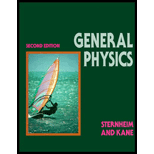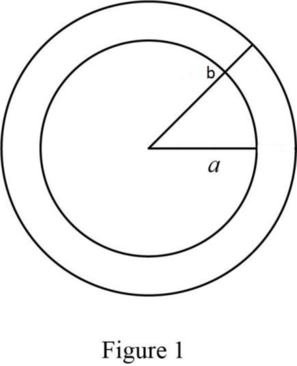
Concept explainers
(a)
The expression for the electric field for
(a)
Answer to Problem 94E
The expression for the electric field for
Explanation of Solution
The below Figure 1 shows the metallic sphere of outer radius

Write the expression for the Gauss’s law.
Here,
Write the expression for the surface area of a hollow sphere.
Conclusion:
Substitute Equation (II) in (I) to find the electric field for
Therefore, the expression for the electric field for
(b)
The expression for the electric field for
(b)
Answer to Problem 94E
The expression for the electric field for
Explanation of Solution
From part (a), the expression for the Gauss’s law is,
And the expression for the surface area of a hollow sphere is,
Use Equation (II) in (I).
The expression for the volume charge density of a hollow sphere is,
Here,
The volume of the insulating hollow sphere for a small element is,
Here,
The charge enclosed by the smallest element in the hollow sphere between
Use Equation (V) in (VI).
Use Equation (VII) in Equation (III).
Conclusion:
Substitute Equation (IV) in (VIII) to find the electric field for
Therefore, the expression for the electric field for
(c)
The expression for the electric field of
(c)
Answer to Problem 94E
The expression for the electric field for
Explanation of Solution
From part (a), the expression for the Gauss’s law is,
The charge
Any charge placed inside hollow spherical conductor attracts opposite charge from sphere.
Since sphere is neutral, an equal and opposite charge appears on inner surface of sphere. The charge inside a
Conclusion:
Therefore, expression for the electric field for
Want to see more full solutions like this?
Chapter 16 Solutions
General Physics, 2nd Edition
- Two infinite, nonconducting sheets of charge are parallel to each other as shown in Figure P19.73. The sheet on the left has a uniform surface charge density , and the one on the right hits a uniform charge density . Calculate the electric field at points (a) to the left of, (b) in between, and (c) to the right of the two sheets. (d) What If? Find the electric fields in all three regions if both sheets have positive uniform surface charge densities of value .arrow_forwardThe nonuniform charge density of a solid insulating sphere of radius R is given by = cr2 (r R), where c is a positive constant and r is the radial distance from the center of the sphere. For a spherical shell of radius r and thickness dr, the volume element dV = 4r2dr. a. What is the magnitude of the electric field outside the sphere (r R)? b. What is the magnitude of the electric field inside the sphere (r R)?arrow_forwardTwo solid spheres, both of radius 5 cm, carry identical total charges of 2 C. Sphere A is a good conductor. Sphere B is an insulator, and its charge is distributed uniformly throughout its volume. (i) How do the magnitudes of the electric fields they separately create at a radial distance of 6 cm compare? (a) EA EB = 0 (b) EA EB 0 (c) EA = EB 0 (d) 0 EA EB (e) 0 = EA EB (ii) How do the magnitudes of the electric fields they separately create at radius 4 cm compare? Choose from the same possibilities as in part (i).arrow_forward
- A thin, square, conducting plate 50.0 cm on a side lies in the xy plane. A total charge of 4.00 108 C is placed on the plate. Find (a) the charge density on each face of the plate, (b) the electric field just above the plate, and (c) the electric field just below the plate. You may assume the charge density is uniform.arrow_forwardFigure P15.49 shows a closed cylinder with cross-sectional area A = 2.00 m2. The constant electric field E has magnitude 3.50 103 N/C and is directed vertically upward, perpendicular to the cylinder's top and bottom surfaces so that no field lines paw through the curved surface. Calculate the electric flux through the cylinder's (a) lop and (b) bottom surface, (c) Determine the amount of charge inside the cylinder. Figure P15.49arrow_forwardA long, straight wire is surrounded by a hollow metal cylinder whose axis coincides with that of the wire. The wire has a charge per unit length of , and the cylinder has a net charge per unit length of 2. From this information, use Gausss law to find (a) the charge per unit length on the inner surface of the cylinder, (b) the charge per unit length on the outer surface of the cylinder, and (c) the electric field outside the cylinder a distance r from the axis.arrow_forward
- A thin, square, conducting plate 50.0 cm on a side lies in the xy plane. A total charge of 4.00 108 C is placed on the plate. Find (a) the charge density on each face of the plate, (b) the electric field just above the plate, and (c) the electric field just below the plate. You may assume the charge density is uniform.arrow_forwardIf there is a a non-uniform, but spherically symmetric, distribution of charge has a charge density ρ(r) given as follows: ρ(r)=ρ0(1−4r/3R)f or r≤R ρ(r)=0 for r≥R where ρ0 is a positive constant. What is the expression for the electric field in the region r <= R?arrow_forwardConsider a thin-shelled hollow tube of length L, radius R with a uniform surface charge density σ and with the z-axis as its central axis. This can be described by: x2 + y2 = R2 and -L/2 ≤ z ≤ L/2. What is the electric field at z0 along the z-axis, where z0 > L/2?arrow_forward
- If a solid insulating sphere of radius 50 cm carries a total charge of 150 µC uniformly distributedthroughout its volume, what is its a) volume charge density? What is the magnitude of the electricfield at b) 10 cm and c) 65 cm from the center of the sphere.arrow_forwardA uniform linear charge density of 7.0 nC/m is distributed along the y axis from y = 2 m to y = 5 m. Which of the following integrals is correct for the magnitude (in N/C) of the electric field at y = 0 on the y axis? Group of answer choicesarrow_forwardA uniform spherical charge distribution has radius R. Which of the following is true of the electric field strength due to the charge distribution at a distance r from the center of the charge? a) It is directly proportional to r when r>R b) It is directly proportional to r when r<RI've been told that the answer is b, but I'm not entirely sure what logic or formulas were used to reach this conclusion.arrow_forward
 Physics for Scientists and Engineers, Technology ...PhysicsISBN:9781305116399Author:Raymond A. Serway, John W. JewettPublisher:Cengage Learning
Physics for Scientists and Engineers, Technology ...PhysicsISBN:9781305116399Author:Raymond A. Serway, John W. JewettPublisher:Cengage Learning Principles of Physics: A Calculus-Based TextPhysicsISBN:9781133104261Author:Raymond A. Serway, John W. JewettPublisher:Cengage Learning
Principles of Physics: A Calculus-Based TextPhysicsISBN:9781133104261Author:Raymond A. Serway, John W. JewettPublisher:Cengage Learning Physics for Scientists and Engineers: Foundations...PhysicsISBN:9781133939146Author:Katz, Debora M.Publisher:Cengage Learning
Physics for Scientists and Engineers: Foundations...PhysicsISBN:9781133939146Author:Katz, Debora M.Publisher:Cengage Learning College PhysicsPhysicsISBN:9781285737027Author:Raymond A. Serway, Chris VuillePublisher:Cengage Learning
College PhysicsPhysicsISBN:9781285737027Author:Raymond A. Serway, Chris VuillePublisher:Cengage Learning




